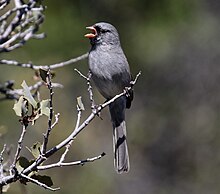| Black-chinned sparrow | |
|---|---|

| |
| Breeding male | |
| Scientific classification | |
| Domain: | Eukaryota |
| Kingdom: | Animalia |
| Phylum: | Chordata |
| Class: | Aves |
| Order: | Passeriformes |
| Family: | Passerellidae |
| Genus: | Spizella |
| Species: | S. atrogularis
|
| Binomial name | |
| Spizella atrogularis (Cabanis, 1851)
| |

| |
| Range of black-chinned sparrow
Breeding Non-Breeding Year-round Migration | |
| Synonyms[2] | |
|
Spinites atrogularis Cabanis, 1851 | |
The black-chinned sparrow (Spizella atrogularis) is a small bird in the genus Spizella, in the New World sparrow family Passerellidae. It is found in the southwestern United States and throughout much of Mexico north of the Isthmus of Tehuantepec; most populations in the US migrate south after breeding while those in Mexico are resident. It is a slim, long-tailed bird, primarily gray with a reddish-brown back streaked with black, brown wings and tail, a pink beak, and brownish legs and feet. In the breeding season, the male shows black on his throat, chin, and the front of his face. Females, youngsters and nonbreeding males show little or no black in these areas. An unobtrusive bird, it spends much of its time foraging slowly along the ground, either alone or in small groups, sometimes mixing with other Spizella species. It is an omnivore, feeding primarily on seeds during the winter and insects during the summer. It builds a cup-shaped nest of grasses, rootlets, or plant fibers, into which the female lays 2–5 pale blue eggs. The female does most or all of the egg incubation, but both parents feed the hatched nestlings.
The species was first described by Jean Louis Cabanis in 1851. Four subspecies have been identified: one breeds only in the US, one only in Mexico, and the other two breed in both countries. Most northern populations move south—primarily into Mexico—for the winter. Because of its apparently large population size and very large range, it is considered to be a species of least concern. However, increasing global temperatures could have a significantly negative impact on its numbers.
- ^ BirdLife International 2021.
- ^ Hellmayr 1938, p. 564.
